Comparison of Indoor Environment and Energy Consumption before and after Spread of COVID-19 in Schools in Japanese Cold-Climate Region
Abstract
:1. Introduction
2. Infection Control in School Facilities
2.1. Characteristics of School Facilities
2.2. Infection Control in School Facilities in Cold Regions
2.3. Target Facilities
2.4. Development of CO2-Concentration Meters with Warning Displays
3. Indoor Environment of Classrooms
4. Changes in Energy Consumption before and after Spread of Novel Coronavirus Infection
4.1. Change in Daily Energy Consumption in Schools with Electric Heaters
4.2. Change of Monthly Primary Energy Consumption
5. Conclusions
- Guidelines for infectious diseases in school buildings in cold regions of Japan were similar to those in warmer regions and inadequate for COVID-19. The problem was that the ventilation methods proposed by the national and local governments could not be continued because of the deterioration in the indoor environment caused by increased ventilation.
- The CO2-concentration meters with warning displays were effective in controlling open-window ventilation. More than 70% of the students participated in the open-window ventilation.
- In total, 90% of students felt hotter than usual in summer, and 40% felt colder than average in winter.
- In total, 40% of the students complained that it was cold, although the room temperature was kept above 18 °C. This is due to the distribution of room temperature and airflow.
- The opening and closing of the windows to increase ventilation did not work well during the coldest months due to students’ complaints of being cold.
- In schools with electric heating, energy consumption increased due to increased ventilation, but not below 0 °C, as windows were closed due to the cold. It means that the ventilation rate did not increase; thus, the ventilation method needs to be improved.
- Calculating the primary energy consumption of 343 schools in Sapporo, 75% showed an increase in the slope of primary energy consumption relative to outdoor temperature after a COVID-19 outbreak. In addition, the increase in slope was about 7%. In other words, the increase in ventilation resulted in a 7% deterioration in energy efficiency.
Author Contributions
Funding
Informed Consent Statement
Acknowledgments
Conflicts of Interest
References
- World Health Organization. Roadmap to Improve and Ensure Good Indoor Ventilation in the Context of COVID-19; World Health Organization: Geneva, Switzerland, 2021. [Google Scholar]
- Sousan, S.; Fan, M.; Outlaw, K.; Williams, S.; Roper, R.L. SARS-CoV-2 Detection in Air Samples from Inside Heating, Ventilation, and Air Conditioning (HVAC) Systems-COVID Surveillance in Student Dorms. Am. J. Infect. Control 2021, 50, 330–335. [Google Scholar] [CrossRef] [PubMed]
- Correia, G.; Rodrigues, L.; Gameiro da Silva, M.; Gonçalves, T. Airborne route and bad use of ventilation systems as non-negligible factors in SARS-CoV-2 transmission. Med. Hypotheses 2020, 141, 109781. [Google Scholar] [CrossRef] [PubMed]
- Lipinski, T.; Ahmad, D.; Serey, N.; Jouhara, H. Review of ventilation strategies to reduce the risk of disease transmission in high occupancy buildings. Int. J. Thermofluids 2020, 7–8, 100045. [Google Scholar] [CrossRef]
- Hayashi, M.; Yanagi, U.; Azuma, K.; Kagi, N.; Ogata, M.; Morimoto, S.; Hayama, H.; Mori, T.; Kikuta, K.; Tanabe, S.; et al. Measures against COVID-19 concerning Summer Indoor Environment in Japan. Jpn. Archit. Rev. 2020, 3, 423–434. [Google Scholar] [CrossRef]
- Hoang, A. Preparation in the Pandemic: How Schools Implemented Air Quality Measures to Protect Occupants from COVID-19; World Health Organization: Geneva, Switzerland, 2021. [Google Scholar]
- RHEVA. REHVA COVID-19 Guidance Document How to Operate HVAC and Other Building Service Systems to Prevent the Spread of the Coronavirus (SARS-CoV-2) Disease (COVID-19) in Workplaces; World Health Organization: Geneva, Switzerland, 2021. [Google Scholar]
- Zheng, W.; Hu, J.; Wang, Z.; Li, J.; Fu, Z.; Li, H.; Jurasz, J.; Chou, S.K.; Yan, J. COVID-19 Impact on Operation and Energy Consumption of Heating, Ventilation and Air-Conditioning (HVAC) Systems. Adv. Appl. Energy 2021, 3, 100040. [Google Scholar] [CrossRef]
- Pan, Y.; Du, C.; Fu, Z.; Fu, M. Re-thinking of engineering operation solutions to HVAC systems under the emerging COVID-19 pandemic. J. Build. Eng. 2021, 43, 102889. [Google Scholar] [CrossRef]
- Elsaid, A.M.; Mohamed, H.A.; Abdelaziz, G.B.; Ahmed, M.S. A critical review of heating, ventilation, and air conditioning (HVAC) systems within the context of a global SARS-CoV-2 epidemic. Process Saf. Environ. Prot. 2021, 155, 230–261. [Google Scholar] [CrossRef]
- Berry, G.; Parsons, A.; Morgan, M.; Rickert, J.; Cho, H. A review of methods to reduce the probability of the airborne spread of COVID-19 in ventilation systems and enclosed spaces. Environ. Res. 2022, 203, 111765. [Google Scholar] [CrossRef]
- Pavilonis, B.; Ierardi, A.M.; Levine, L.; Mirer, F.; Kelvin, E.A. Estimating aerosol transmission risk of SARS-CoV-2 in New York City public schools during reopening. Environ. Res. 2021, 195, 110805. [Google Scholar] [CrossRef]
- Rita, E.; Chizoo, E.; Cyril, U.S. Sustaining COVID-19 pandemic lockdown era air pollution impact through utilization of more renewable energy resources. Heliyon 2021, 7, e07455. [Google Scholar] [CrossRef]
- Gil-Baez, M.; Lizana, J.; Becerra Villanueva, J.A.; Molina-Huelva, M.; Serrano-Jimenez, A.; Chacartegui, R. Natural ventilation in classrooms for healthy schools in the COVID era in Mediterranean climate. Build. Environ. 2021, 206, 108345. [Google Scholar] [CrossRef]
- Stabile, L.; Buonanno, G.; Frattolillo, A.; Dell’Isola, M. The effect of the ventilation retrofit in a school on CO2, airborne particles, and energy consumptions. Build. Environ. 2019, 156, 1–11. [Google Scholar] [CrossRef]
- Haddad, S.; Synnefa, A.; Ángel Padilla Marcos, M.; Paolini, R.; Delrue, S.; Prasad, D.; Santamouris, M. On the potential of demand-contsrolled ventilation system to enhance indoor air quality and thermal condition in Australian school classrooms. Energy Build. 2021, 238, 110838. [Google Scholar] [CrossRef]
- Schibuola, L.; Tambani, C. High energy efficiency ventilation to limit COVID-19 contagion in school environments. Energy Build. 2021, 240, 110882. [Google Scholar] [CrossRef]
- Ascione, F.; De Masi, R.F.; Mastellone, M.; Vanoli, G.P. The design of safe classrooms of educational buildings for facing contagions and transmission of diseases: A novel approach combining audits, calibrated energy models, building performance (BPS) and computational fluid dynamic (CFD) simulations. Energy Build. 2021, 230, 110533. [Google Scholar] [CrossRef]
- Simanic, B.; Nordquist, B.; Bagge, H.; Johansson, D. Indoor air temperatures, CO2 concentrations and ventilation rates: Long-term measurements in newly built low-energy schools in Sweden. J. Build. Eng. 2019, 25, 100827. [Google Scholar] [CrossRef]
- Bugenings, L.A.; Schaffer, M.; Larsen, O.K.; Zhang, C. A novel solution for school renovations: Combining diffuse ceiling ventilation with double skin facade. J. Build. Eng. 2022, 49, 104026. [Google Scholar] [CrossRef]
- Peng, Z.; Deng, W.; Tenorio, R. An integrated low-energy ventilation system to improve indoor environment performance of school buildings in the cold climate zone of China. Build. Environ. 2020, 182, 107153. [Google Scholar] [CrossRef]
- Li, X.; Zheng, S.; Tian, G.; Zhang, L.; Yao, W. A new energy saving ventilation system assisted by transpired solar air collectors for primary and secondary school classrooms in winter. Build. Environ. 2020, 177, 106895. [Google Scholar] [CrossRef]
- Munday, J.D.; Sherratt, K.; Meakin, S.; Endo, A.; Pearson, C.A.B.; Hellewell, J.; Abbott, S.; Bosse, N.I.; Eggo, R.M.; Simons, D.; et al. Implications of the school-household network structure on SARS-CoV-2 transmission under school reopening strategies in England. Nat. Commun. 2021, 12, 1942. [Google Scholar] [CrossRef]
- Mai, H.; Taro, M.; Hirofumi, H.; Motoya, H. Transitional analysis on seasonal dependence of death from disease using the vital statistics. J. Environ. Eng. 2021, 86, 557–566. [Google Scholar] [CrossRef]
- REHVA. REHVA_COVID-19_guidance_document_V3_03082020; 2020. Available online: https://www.cdc.gov/vaccines/covid-19/covid19-vaccination-guidance.html (accessed on 6 July 2021).
- Donohue, J.M.; Miller, E. COVID-19 and School Closures. JAMA-J. Am. Med. Assoc. 2020, 324, 845–847. [Google Scholar] [CrossRef]
- Ertem, Z.; Schechter-Perkins, E.M.; Oster, E.; van den Berg, P.; Epshtein, I.; Chaiyakunapruk, N.; Wilson, F.A.; Perencevich, E.; Pettey, W.B.P.; Branch-Elliman, W.; et al. The impact of school opening model on SARS-CoV-2 community incidence and mortality. Nat. Med. 2021, 27, 2120–2126. [Google Scholar] [CrossRef]
- Gurdasani, D.; Alwan, N.A.; Greenhalgh, T.; Hyde, Z.; Johnson, L.; McKee, M.; Michie, S.; Prather, K.A.; Rasmussen, S.D.; Reicher, S.; et al. School reopening without robust COVID-19 mitigation risks accelerating the pandemic. Lancet 2021, 397, 1177–1178. [Google Scholar] [CrossRef]
- Aiano, F.; Mensah, A.A.; McOwat, K.; Obi, C.; Vusirikala, A.; Powell, A.A.; Flood, J.; Bosowski, J.; Letley, L.; Jones, S.; et al. COVID-19 outbreaks following full reopening of primary and secondary schools in England: Cross-sectional national surveillance, November 2020. Lancet Reg. Health-Eur. 2021, 6, 100120. [Google Scholar] [CrossRef] [PubMed]
- Stein-Zamir, C.; Abramson, N.; Shoob, H.; Libal, E.; Bitan, M.; Cardash, T.; Cayam, R.; Miskin, I. A large COVID-19 outbreak in a high school 10 days after schools’ reopening, Israel, May 2020. Eurosurveillance 2020, 25, 2001352. [Google Scholar] [CrossRef] [PubMed]
- Vlachos, J.; Hertegård, E.; Hertegård, H.; Svaleryd, H.B. The effects of school closures on SARS-CoV-2 among parents and teachers. Proc. Natl. Acad. Sci. USA 2021, 118, e2020834118. [Google Scholar] [CrossRef]
- Lam-Hine, T.; Mccurdy, S.A.; Santora, L.; Duncan, L.; Corbett-Detig, R.; Kapusinszky, B.; Willis, M. Morbidity and Mortality Weekly Report Outbreak Associated with SARS-CoV-2 B.1.617.2 (Delta) Variant in an Elementary School-Marin County, California, May–June 2021; Centers for Disease Control and Prevention (U.S.): Atlanta, GA, USA, 2021. [Google Scholar]
- Fukumoto, K.; McClean, C.T.; Nakagawa, K. No causal effect of school closures in Japan on the spread of COVID-19 in spring 2020. Nat. Med. 2021, 27, 2111–2119. [Google Scholar] [CrossRef]
- Lessler, J.; Grabowski, M.K.; Grantz, K.H.; Badillo-Goicoechea, E.; Jessica, C.; Metcalf, E.; Lupton-Smith, C.; Azman, A.S.; Stuart, E.A. Household COVID-19 risk and in-person schooling. Science 2021, 372, 1092–1097. [Google Scholar] [CrossRef]
- Ministry of Education, CSS and T. School Environmental Hygiene Management Manual Theory and Practice of School Environmental Hygiene Standards. Available online: https://www.mext.go.jp/component/a_menu/education/detail/__icsFiles/afieldfile/2018/07/31/1292465_01.pdf (accessed on 19 September 2021).
- AIJ Thermal and Air Environment in Schools Current Problems and Countermeasures-to Create a Healthy and Comfortable Learning Environment for Children. Available online: http://news-sv.aij.or.jp/kankyo/s7/school_air_guide.pdf (accessed on 19 September 2021).
- Hokkaido Research Organization Building Research Department. How to Ventilate Schools for the Cold Winter Months in Hokkaido. Available online: http://www.hro.or.jp/list/building/koho/develop/gakko_kannki.html (accessed on 19 September 2021).
- McNeill, V.F.; Corsi, R.; Huffman, J.A.; King, C.; Klein, R.; Lamore, M.; Maeng, D.Y.; Miller, S.L.; Lee Ng, N.; Olsiewski, P.; et al. Room-level ventilation in schools and universities. Atmos. Environ. X 2022, 13, 100152. [Google Scholar] [CrossRef]
- Milošević, D.; Middel, A.; Savić, S.; Dunjić, J.; Lau, K.; Stojsavljević, R. Mask wearing behavior in hot urban spaces of Novi Sad during the COVID-19 pandemic. Sci. Total Environ. 2022, 815, 152782. [Google Scholar] [CrossRef]
- Budzyn, S.E.; Panaggio, M.J.; Parks, S.E.; Papazian, M.; Magid, J.; Barrios, L.C. Morbidity and Mortality Weekly Report Pediatric COVID-19 Cases in Counties with and without School Mask Requirements-United States, July 1–September 4, 2021. MMWR Morb. Mortal. Wkly. Rep. 2021, 70, 1377–1378. [Google Scholar] [CrossRef]
- Theuring, S.; Thielecke, M.; Van Loon, W.; Hommes, F.; Hülso, C.; Von Der Haar, A.; Körner, J.; Schmidt, M.; Böhringer, F.; Mall, M.A.; et al. SARS-CoV-2 infection and transmission in school settings during the second COVID-19 wave: A crosssectional study, Berlin, Germany, November 2020. Eurosurveillance 2021, 26, 2100184. [Google Scholar] [CrossRef]
- Zimmerman, K.O.; Brookhart, M.A.; Kalu, I.C.; Boutzoukas, A.E.; McGann, K.A.; Smith, M.J.; Panayotti, G.M.M.; Armstrong, S.C.; Weber, D.J.; Moorthy, G.S.; et al. Community SARS-CoV-2 surge and within-school transmission. Pediatrics 2021, 148, e2021052686. [Google Scholar] [CrossRef]
- Kawka, E.; Cetin, K. Impacts of COVID-19 on residential building energy use and performance. Build. Environ. 2021, 205, 108200. [Google Scholar] [CrossRef]
- Honein, M.A.; Barrios, L.C.; Brooks, J.T. Data and Policy to Guide Opening Schools Safely to Limit the Spread of SARS-CoV-2 Infection. JAMA-J. Am. Med. Assoc. 2021, 325, 823–824. [Google Scholar] [CrossRef]
- Kang, H.; An, J.; Kim, H.; Ji, C.; Hong, T.; Lee, S. Changes in energy consumption according to building use type under COVID-19 pandemic in South Korea. Renew. Sustain. Energy Rev. 2021, 148, 111294. [Google Scholar] [CrossRef]

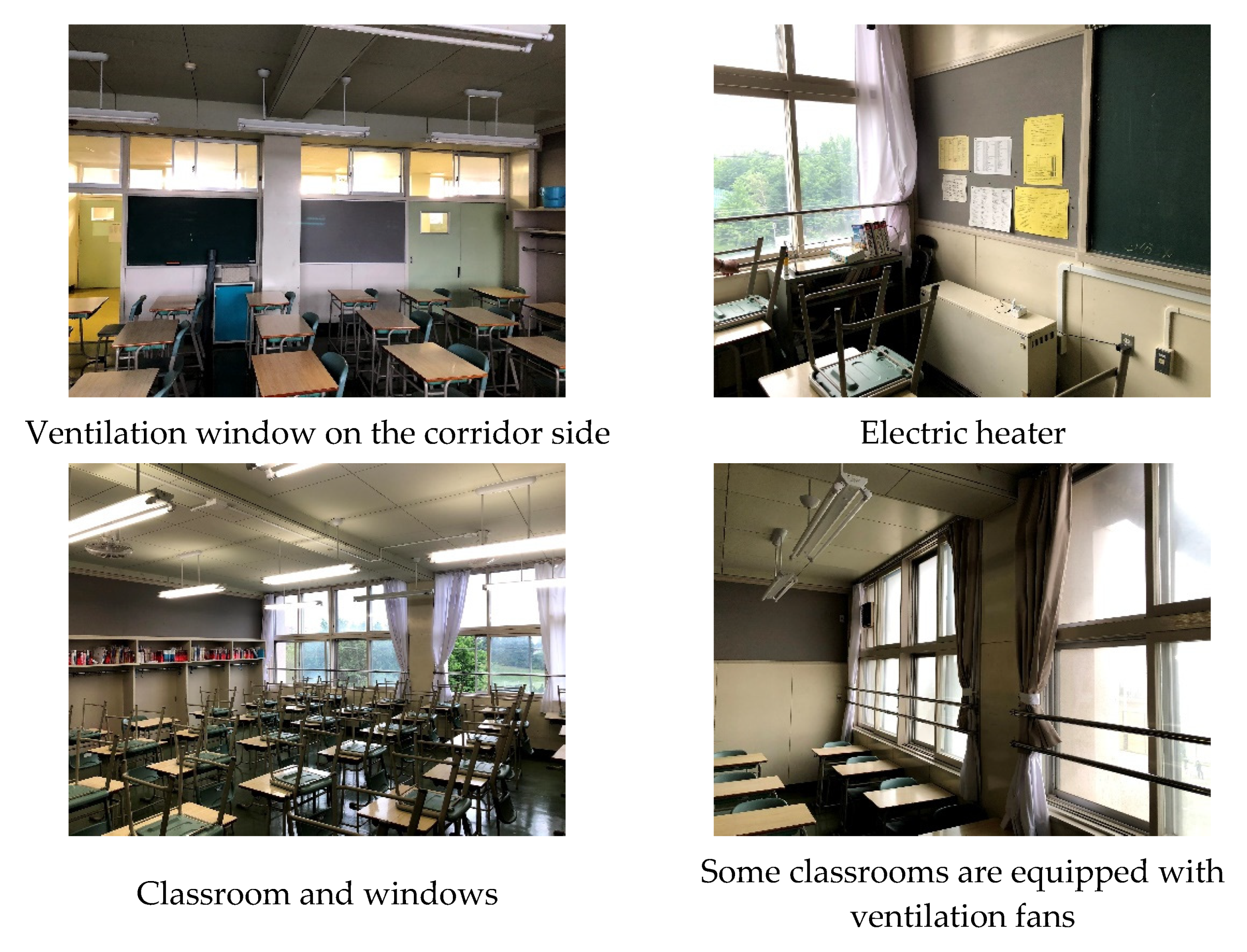
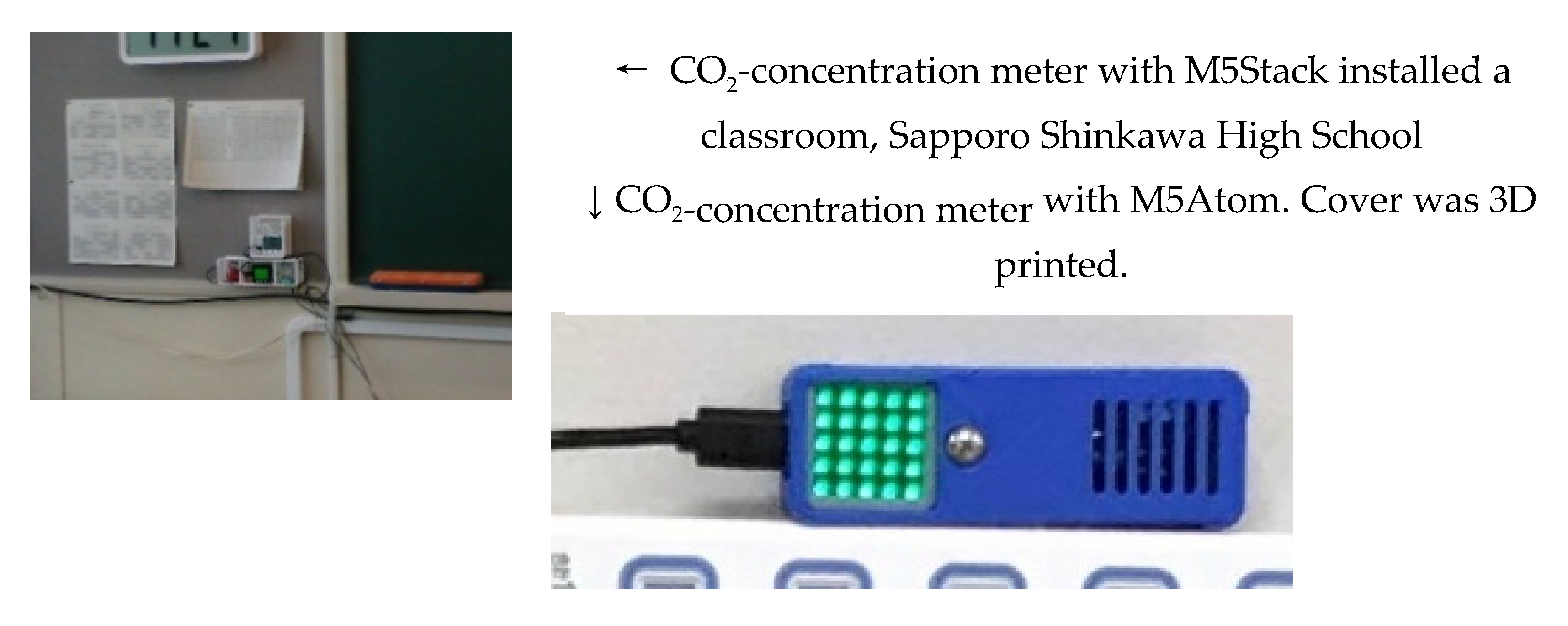

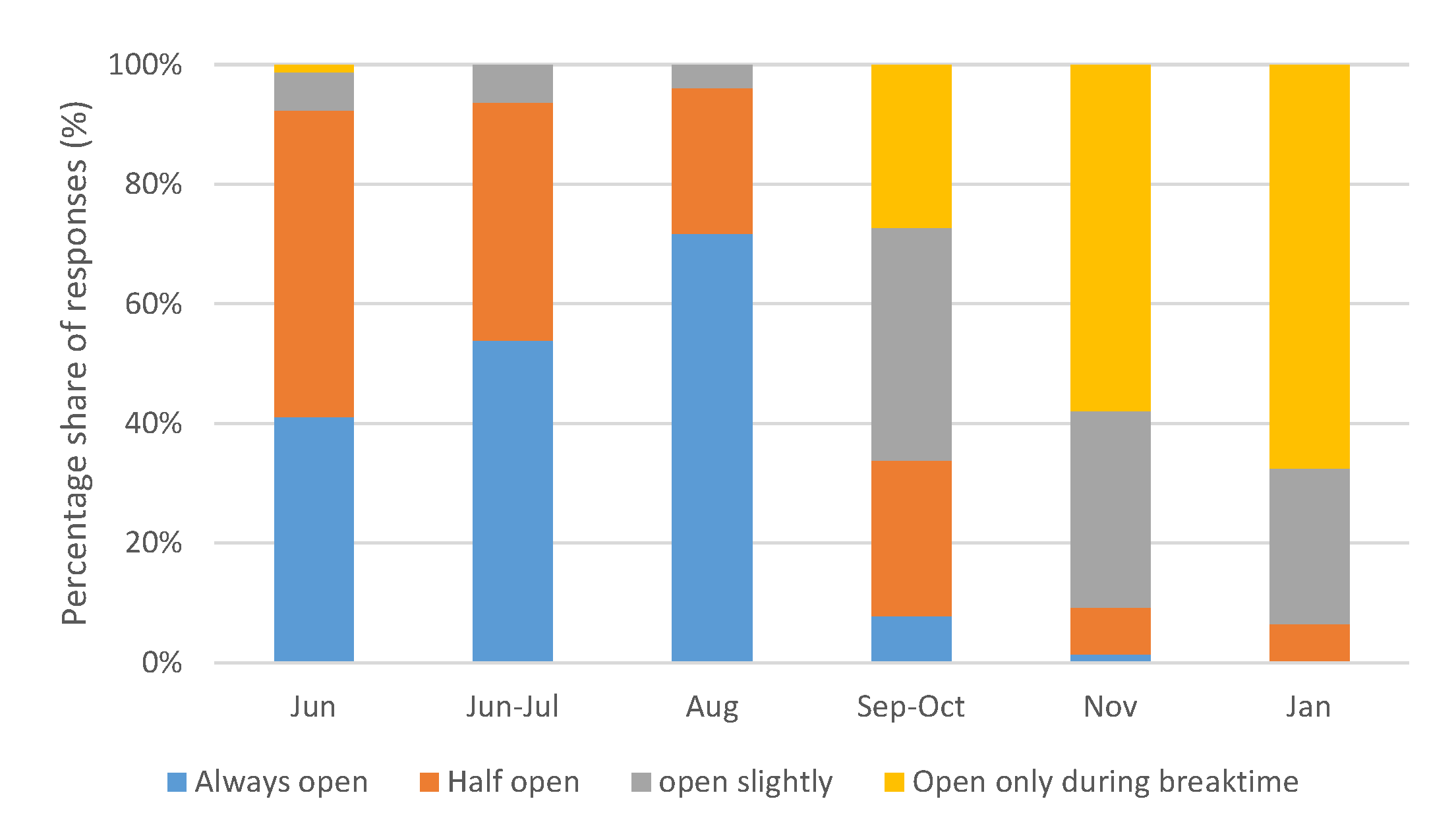
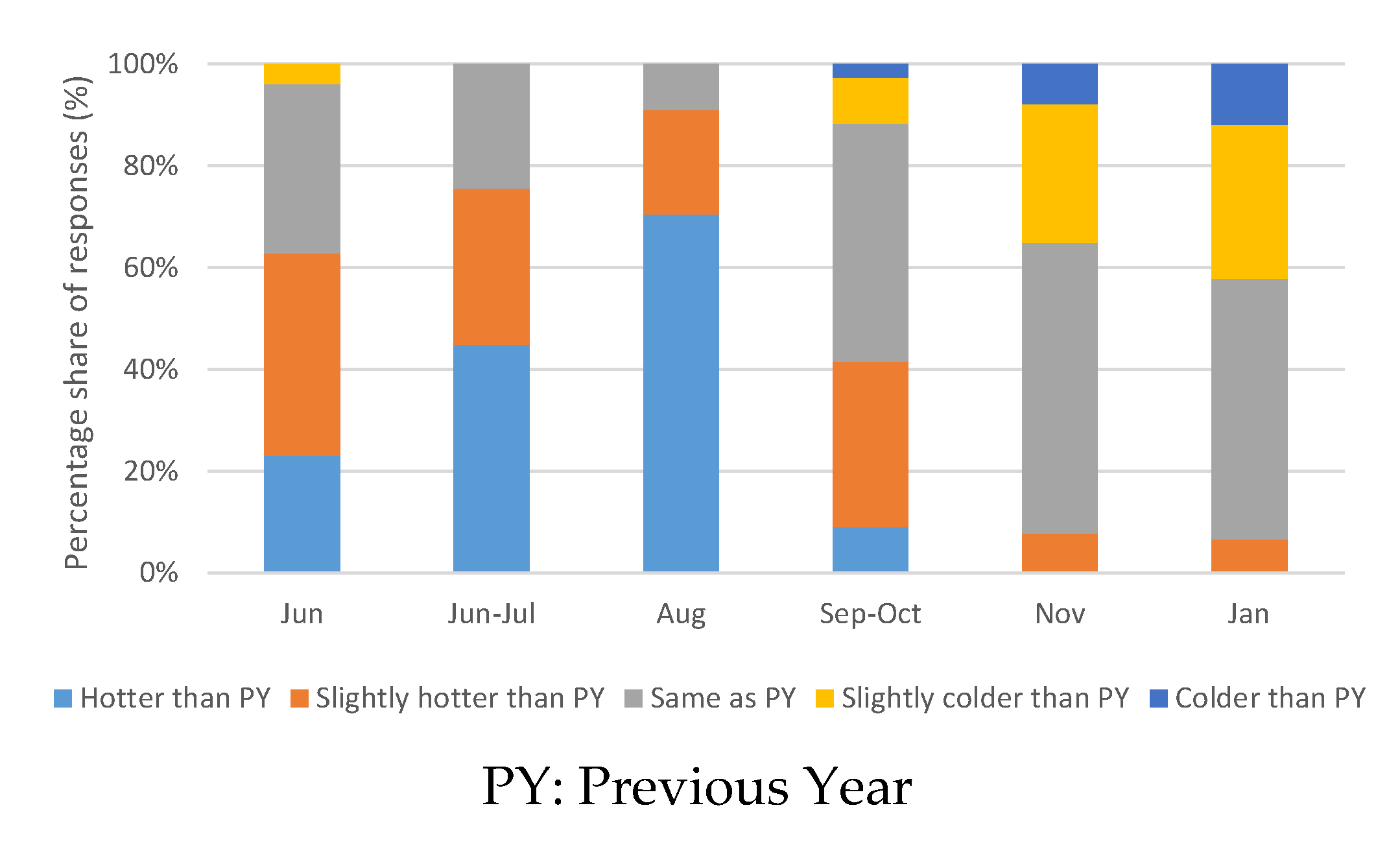
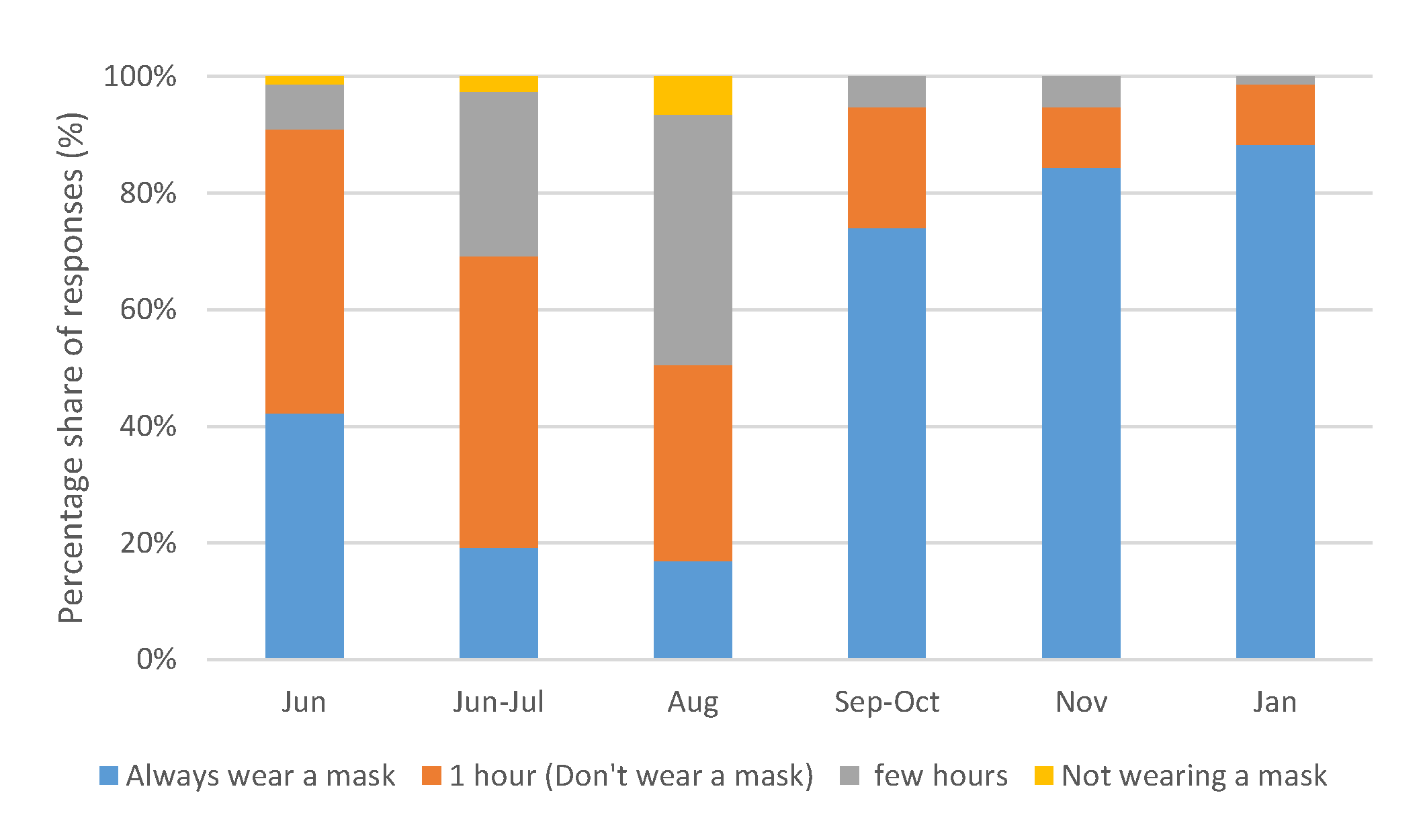
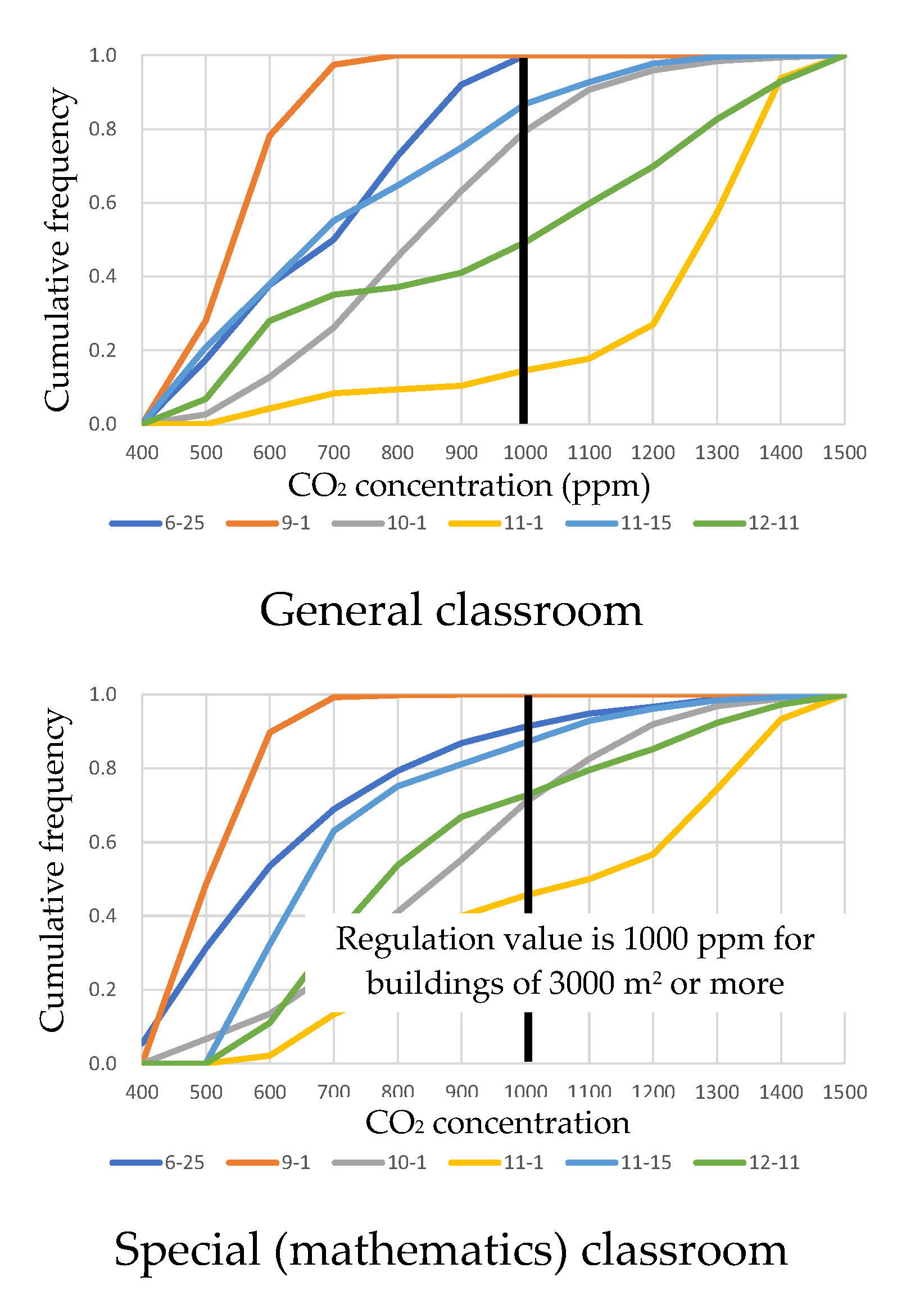
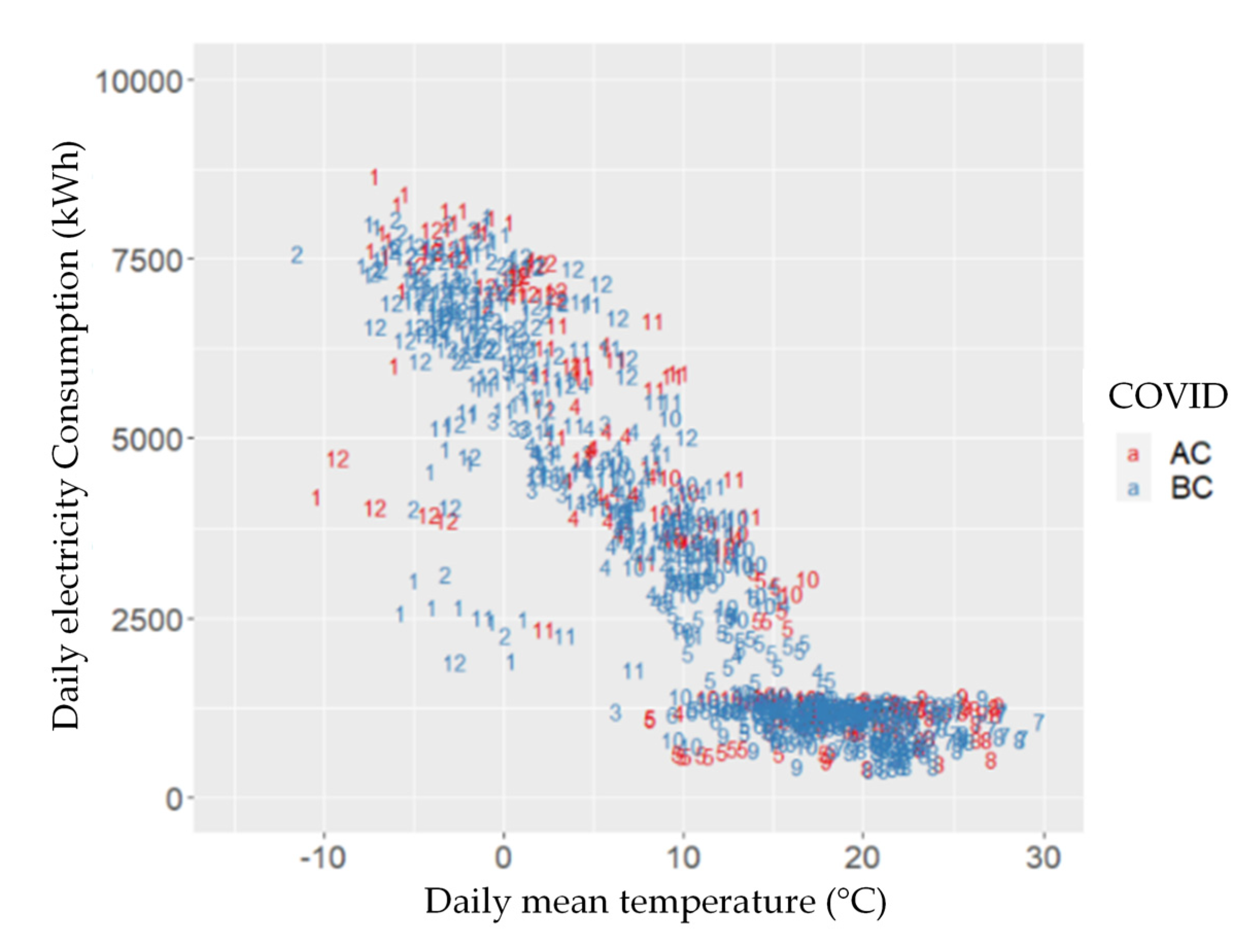
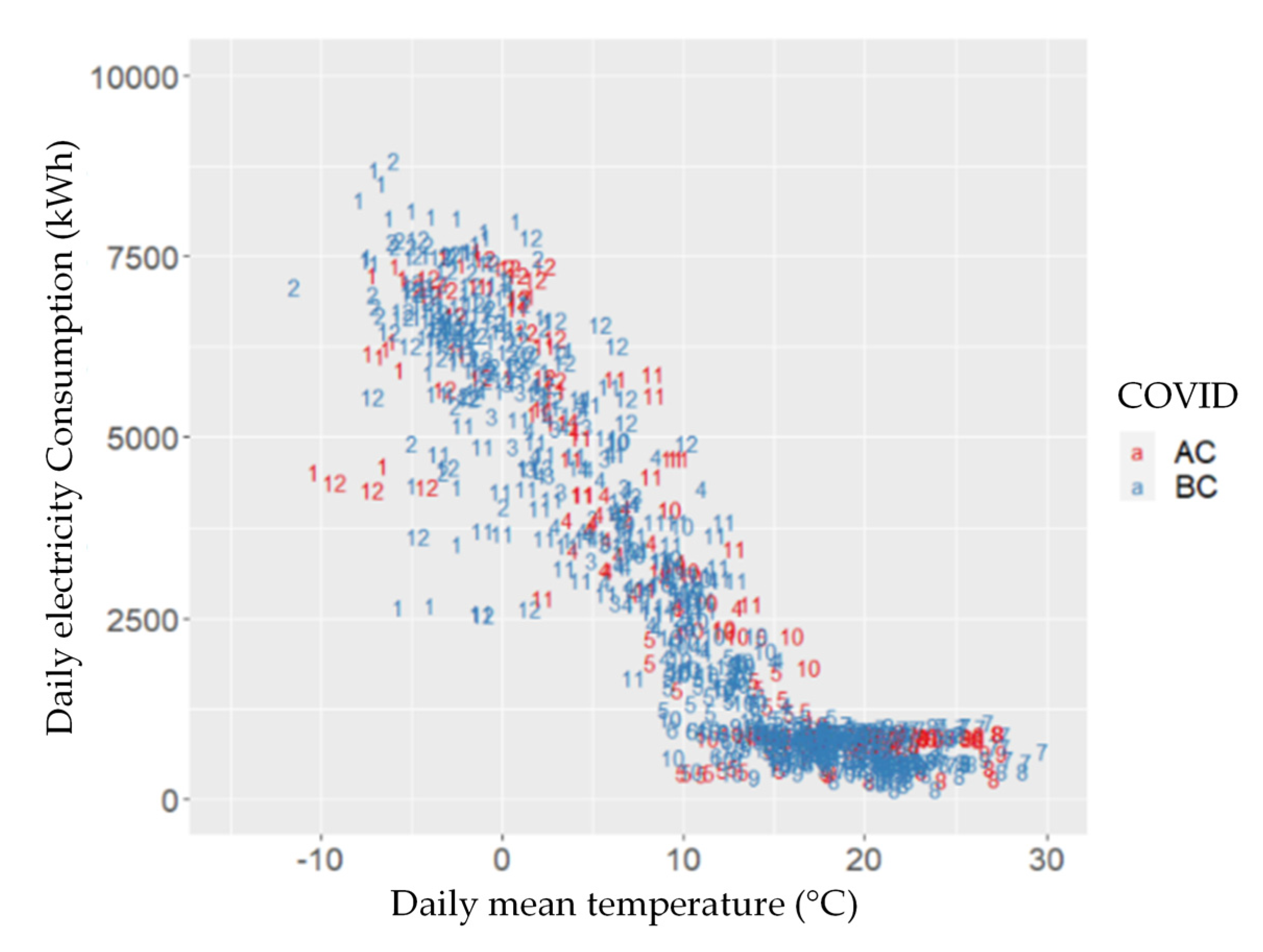
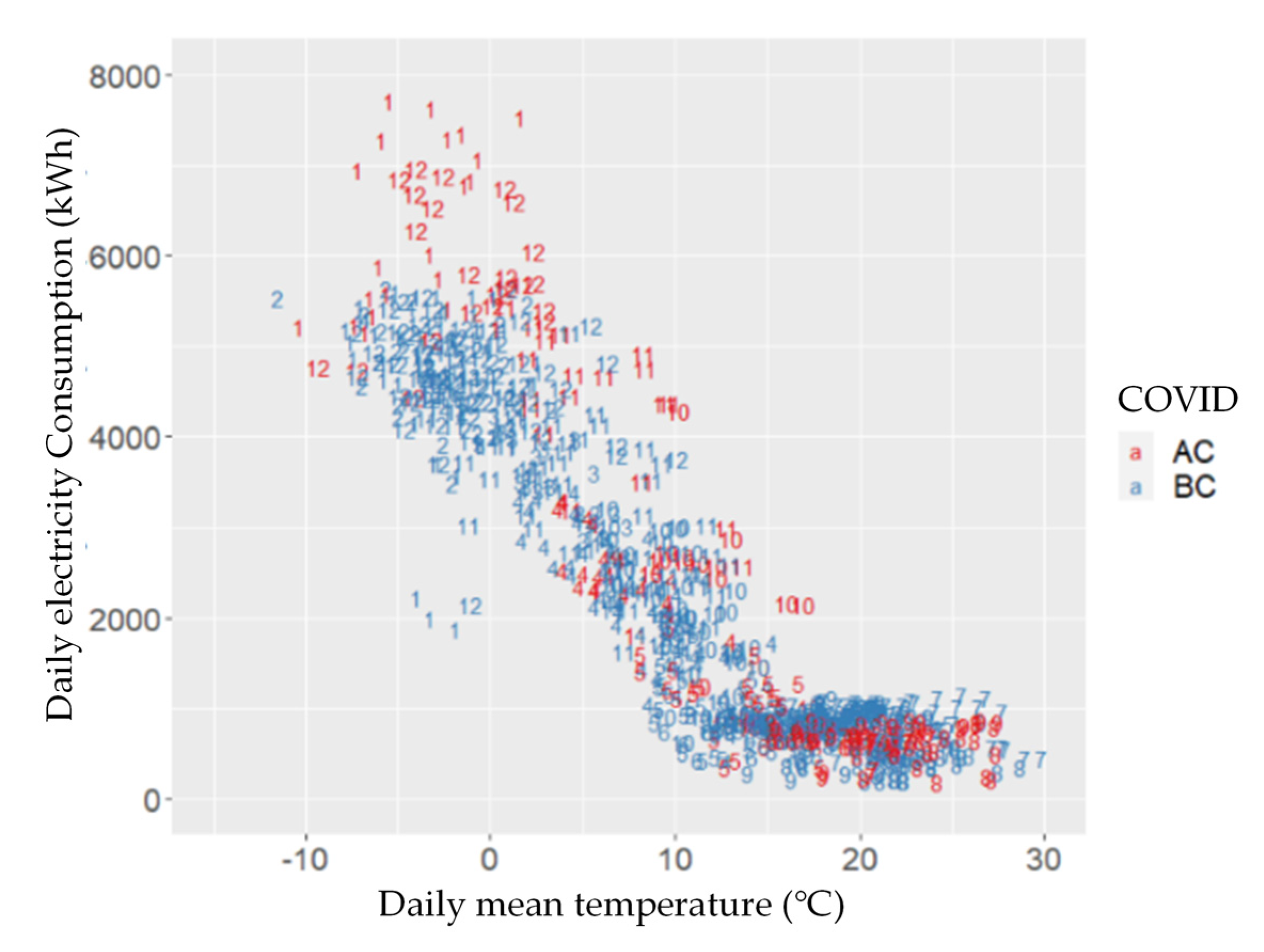

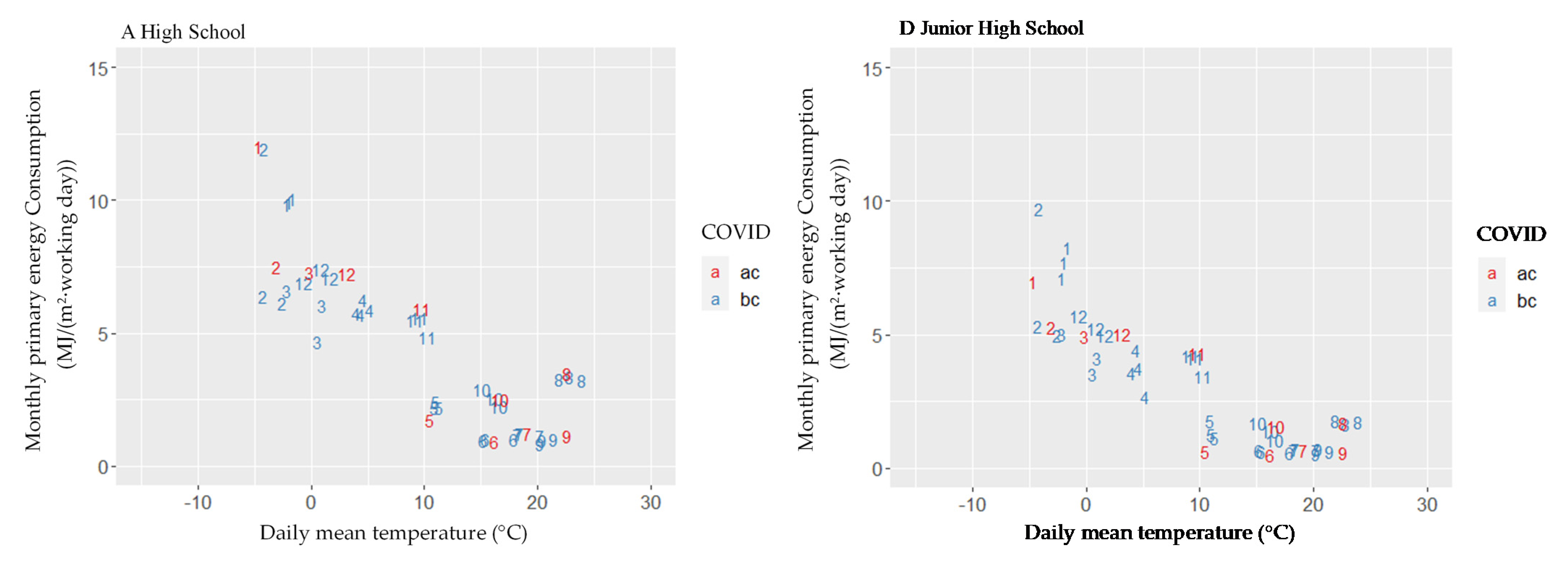
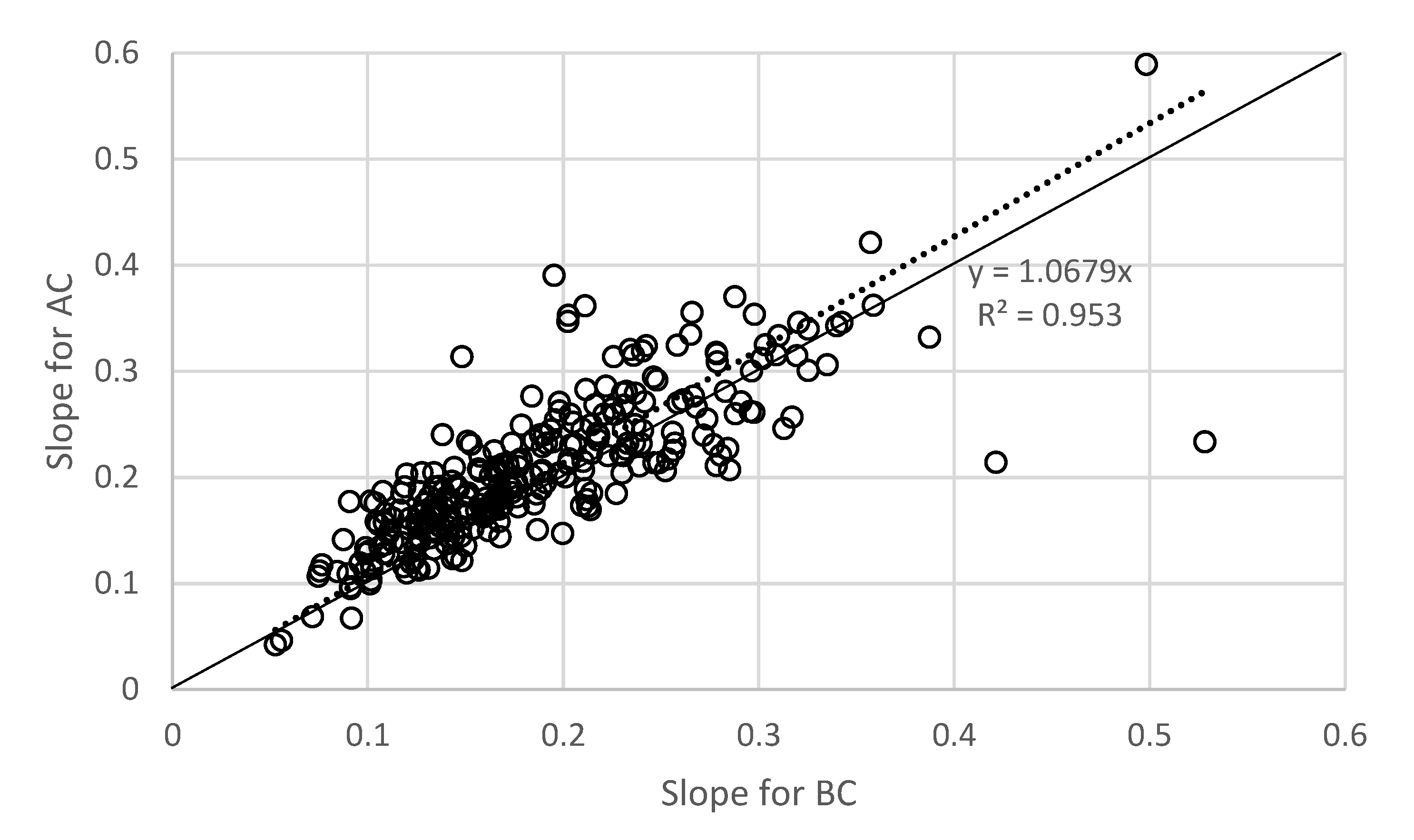
| School Name | Floor Area [m2] | Heating System |
|---|---|---|
| A High School | 12,255 | Electric heater |
| B High School | 10,541 | Electric heater |
| C Junior High School | 10,202 | Electric heater |
| D Junior High School | 9702 | Heavy oil and kerosene oil boiler |
| E Elementary School | 6346 | Electric heater |
| School Name | Slope in BC | Slope in AC | ISC in BC | ISC in AC | R2 BC | R2 AC |
|---|---|---|---|---|---|---|
| A High School | −257 | <−265 | 18.1 | 20.2 | 0.60 | 0.67 |
| B High School | −335 | >−318 | 14.3 | 15.8 | 0.72 | 0.68 |
| C Junior High School | −225 | <−259 | 13.9 | 15.4 | 0.66 | 0.52 |
| E Elementary School | −124 | <−172 | 14.5 | 15.8 | 0.57 | 0.58 |
Publisher’s Note: MDPI stays neutral with regard to jurisdictional claims in published maps and institutional affiliations. |
© 2022 by the authors. Licensee MDPI, Basel, Switzerland. This article is an open access article distributed under the terms and conditions of the Creative Commons Attribution (CC BY) license (https://creativecommons.org/licenses/by/4.0/).
Share and Cite
Mori, T.; Akamatsu, T.; Kuwabara, K.; Hayashi, M. Comparison of Indoor Environment and Energy Consumption before and after Spread of COVID-19 in Schools in Japanese Cold-Climate Region. Energies 2022, 15, 1781. https://doi.org/10.3390/en15051781
Mori T, Akamatsu T, Kuwabara K, Hayashi M. Comparison of Indoor Environment and Energy Consumption before and after Spread of COVID-19 in Schools in Japanese Cold-Climate Region. Energies. 2022; 15(5):1781. https://doi.org/10.3390/en15051781
Chicago/Turabian StyleMori, Taro, Taisei Akamatsu, Kouhei Kuwabara, and Motoya Hayashi. 2022. "Comparison of Indoor Environment and Energy Consumption before and after Spread of COVID-19 in Schools in Japanese Cold-Climate Region" Energies 15, no. 5: 1781. https://doi.org/10.3390/en15051781
APA StyleMori, T., Akamatsu, T., Kuwabara, K., & Hayashi, M. (2022). Comparison of Indoor Environment and Energy Consumption before and after Spread of COVID-19 in Schools in Japanese Cold-Climate Region. Energies, 15(5), 1781. https://doi.org/10.3390/en15051781






